This region was initially a low-lying area subject to seasonal flooding and historically once part of the river Yamuna‘s flood plain. In the eighteenth century, Maharaj Suraj Mal, ruler of the State of Bharatpur, built the Ajan Bund, a 3270-ha impoundment. The bund had two purposes; one to prevent floods and also as a water reservoir for agricultural purposes. During 1850-1899 Prince Harbhamji of Morvi State in Gujarat modified the area considerably, by devising a system of canals and dykes for controlling water. This was done to develop this area into a duck shoot reserve and provide grazing avenues for the village cattle.
यह क्षेत्र शुरू में मौसमी बाढ़ के अधीन एक निचला क्षेत्र था और ऐतिहासिक रूप से एक बार यमुना नदी के बाढ़ मैदान का हिस्सा था। अठारहवीं शताब्दी में, भरतपुर राज्य के शासक महाराज सूरजमल ने 3270 हेक्टेयर भूमि पर अजान बांध का निर्माण कराया था। बाँध के दो उद्देश्य थे; एक बाढ़ को रोकने के लिए और कृषि उद्देश्यों के लिए जल भंडार के रूप में भी। 1850-1899 के दौरान गुजरात में मोरवी राज्य के राजकुमार हरभमजी ने पानी को नियंत्रित करने के लिए नहरों और बांधों की एक प्रणाली तैयार करके क्षेत्र में काफी बदलाव किया। ऐसा इस क्षेत्र को बत्तख शूट रिजर्व के रूप में विकसित करने और गांव के मवेशियों के लिए चराई के अवसर प्रदान करने के लिए किया गया था।
(Source: Display/Notice Board at Keoladeo Ghana National Park)
Click to watch more about Keoladeo Ghana National Park.


